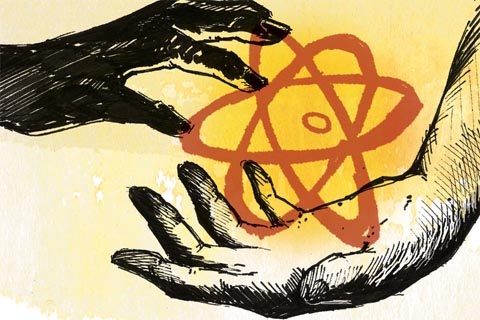Here's everything you need to know:
Why use nuclear power?
To prevent catastrophic climate change, scientists say, we have to dramatically reduce the use of fossil fuels. The latest report from the Intergovernmental Panel on Climate Change warned that more extreme droughts, floods, wildfires, and storms will occur if world carbon dioxide emissions do not drop by 45 percent from 2010 levels by 2030 and get to zero by 2050. Replacing coal- and oil-burning power plants with renewable sources such as wind, solar, and hydroelectric power is crucial to that goal, but renewables alone won't be enough to meet the world's energy needs, particularly in rapidly developing countries like China and India, where the demand for electricity is soaring. That's why some energy experts argue that only by keeping existing nuclear plants open and building dozens of new ones can countries reduce their emissions fast enough.
Why can't renewables do the job?
Solar and wind farms sprawl out over vast amounts of land, and these sources only work when the sun is shining and the wind is blowing. Building all that infrastructure, including transmission lines, is costly for governments and hard on the environment, and often meets strong local resistance. In California, where sunshine is reliable, a solar farm takes up 450 times as much land as a nuclear plant, and vastly more concrete and steel, to produce the same amount of energy.
What was the result of the closures?
Germany, which decided to phase out nuclear entirely, has invested $580 billion in renewables and achieved 38 percent green energy. But its electricity prices are now the highest in Europe, while its carbon emissions have stayed flat. Why? Because after the nuclear shutdown, Germany had to keep burning coal and natural gas to prevent a massive slump in energy production. Experts say it will likely take decades to scale up solar and wind to levels envisioned by no-emissions activists. Similarly, Vermont shut its only nuclear reactor in 2014 and turned to natural gas. Vermont's per capita emissions have since risen 5 percent during a period in which overall U.S. emissions declined by 17 percent. In a new book, A Bright Future, Swedish engineer Staffan Qvist and American international relations professor Joshua Goldstein point to Sweden as a model for the rest of the world. Sweden's eight nuclear plants supply 40 percent of the country's electricity, while hydropower, wind, and biofuels supply the rest. The result? Sweden's carbon emissions dropped by half while its electricity production doubled.
What about nuclear accidents?
The fear of radiation and a catastrophic plant meltdown is the crux of opposition to nuclear power. But a rational analysis of the numbers tells a different story. The worst nuclear accident, the 1986 meltdown at Chernobyl, occurred at a primitive, Soviet-built reactor, and it killed 60 people almost immediately and a few thousand over later decades, while Japan's Fukushima disaster killed just one from radiation (tens of thousands died in the earthquake and tsunami). Industrial accidents, meanwhile, routinely cause far greater loss of life. And the smoke and chemicals emitted from burning fossil fuels and biomass kills a staggering seven million people every year. Climate scientist James Hansen concluded in a study that nuclear plants have actually saved nearly two million lives that would have been lost to air pollution.
Source: The Week Magazine

Why use nuclear power?
To prevent catastrophic climate change, scientists say, we have to dramatically reduce the use of fossil fuels. The latest report from the Intergovernmental Panel on Climate Change warned that more extreme droughts, floods, wildfires, and storms will occur if world carbon dioxide emissions do not drop by 45 percent from 2010 levels by 2030 and get to zero by 2050. Replacing coal- and oil-burning power plants with renewable sources such as wind, solar, and hydroelectric power is crucial to that goal, but renewables alone won't be enough to meet the world's energy needs, particularly in rapidly developing countries like China and India, where the demand for electricity is soaring. That's why some energy experts argue that only by keeping existing nuclear plants open and building dozens of new ones can countries reduce their emissions fast enough.
Tuesday, December 1, 2020



